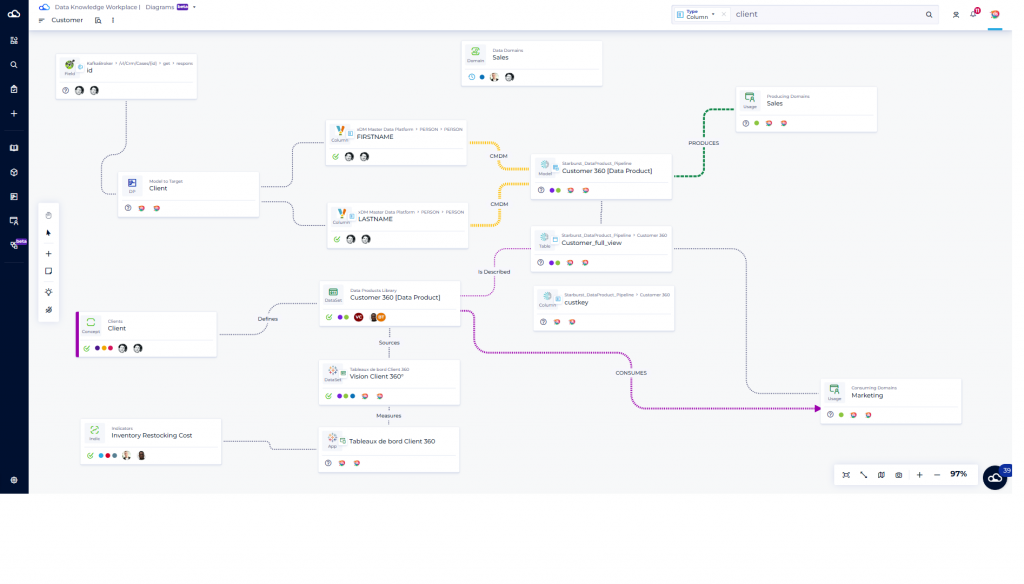The Customer Master Data Management system (CMDM) typically includes information about a company’s customers, such as their names, addresses, contact details, and other relevant data. It might even contain some transactional or purchase profile data. This data is used by various systems and applications within an organization, such as CRM, ERP, and marketing automation systems.
The metadata catalog, on the other hand, is a source of information about the organization’s data assets, including data definitions, data lineage, potential usage, profiling, sensitivity, data quality, and permissions information. The metadata catalog provides a centralized view of the organizational data, making it easier to manage, discover, and understand.
When evaluating a metadata catalog for consideration for your enterprise, there are several key features to consider that can help solve practical business problems.
The first problem to consider is data integration. A significant challenge for enterprises face is integrating data from disparate sources. A metadata catalog should be able to integrate data from different systems like the Pretectum CMDM and make it accessible through a single interface. This feature helps to solve the business problem of the proliferation of data silos and inefficient data management practices.
Data accuracy is a plague on effective data use. The Pretectum CMDM helps with managing aspects of this but organizations that have multiple data repositories will have non-customer data that is at risk of being inaccurate, unsecured, and suffering non-compliant handling. The metadata catalog may be able to provide data governance features that improve and put into effect specific data governance practices by surfacing characteristics like data lineage, and data quality metrics, and enforcing or at least revealing data access controls.
All of these aspects help to serve the business problem of meeting regulatory compliance expectations and providing data security assurance.
Finding the most relevant sources and targets of data should be a basic metadata catalog task, these are even useful insights for building the CMDM. An organization should be able to help users quickly and easily discover the data they need. Data discovery helps to solve the business problem of inefficient data search, which may lead to poor decision-making, duplicative work, data proliferation, and inefficient or even risky operational practices
Understanding where the customer data comes from is all very well surfaced in the CMDM but the metadata catalog can also tell how pipelines and staging areas may have been transformed from the source to the CMDM target. It is essential for data governance and decision-making that the metadata catalog be able to track data lineage and provide information about data origins, transformations, and usage.
This feature helps to root out the sources that create the business problem of data quality erosion which in turn impacts decision-making and results in incomplete or inaccurate data-based decisions.

The modern data-driven organization typically has multiple teams working with customer data. This is why the Pretectum CMDM supports the provisioning of multiple business areas. The kinds of users who might use the CMDM and the metadata catalog include members of the data science community as well as other kinds of data analysts, and certain business users.
A modern metadata catalog supports collaborations, that enable disparate teams in being able to work together more efficiently. With both systems in tow, they can share information, provide one another feedback, identify data ownership, and annotate various details. Collaboration helps in breaking down organizational silos.
As the organization grows, its data needs grow also. A modern metadata catalog scales to accommodate larger volumes of data and increasing numbers of users. This in turn helps to solve the business problem of data access restrictiveness, poor performance, and inefficient data management. Oftentimes analysts and data engineers don’t need actual access to the data, they simply need to know where to get it and who is responsible for it. The modern metadata catalog should be a help in this area.
The union of a customer master data system (CMDM) and the modern metadata catalog occurs when the metadata catalog is used to manage and govern the logical understanding of the physical sources and targets of customer master data. The metadata is used to provide users and systems with information about the structure, content, and quality of the customer master data, creating confidence and making it easier to manage and use customer data with more trust and more effectively.
As Laurent Dresse, Chief Evangelist at DataGalaxy says “Having a Customer master data is an important step towards data management and data quality but most importantly you need to inform your organization of the available customer attributes. This is where the data catalog and metadata management platforms are playing an important role.
At DataGalaxy, we help enterprises to better understand and contextualize their transactional and master data.
You know exactly where the data is coming from and where it is consumed. It creates trust at the business level and avoids further delays in ownership identification and data quality remediation process“
Definitions of quality in the metadata catalog can be used to define and document the attributes of customer master data, such as the data type, format, and business rules, these can also be compared with those in the CMDM. This information can then be used to ensure the consistency and accuracy of the customer master data across different systems and applications.
The intersection of customer master data and the metadata catalog is the use of metadata to provide management assurance and data governance assurances around customer master data. By using metadata to provide information about the structure, content, and quality of customer master data, organizations can improve the efficiency and effectiveness of their data management processes.


